According to the number of
morphemes words are classified into monomorphic and
polymorphic.
Momnomorphic
or root-words consist of only one root-morpheme.
Polymorphic words
consist of root and non-root morphemes. According to the number of
root-morphemes all polymorphic words are divided into two groups:
monoradical or one-root words and
polyradical words which consist of two or more
roots.
According to the type of
affixes monoradical words fall into three subtypes:
radical-suffixal, radical-prefixal
and prefixo-radical-suffixal words.
Radical-suffixal
words consist of one root-morpheme and one or more suffixal
morphemes.
Radical-prefixal
words consist of one root-morpheme and a prefixal morpheme.
Prefixo-radical-suffixal
words consist of one root-morpheme and prefixal and suffixal
morphemes.
Polyradical words
fall into two types: (1) polyradical words of two or more roots with
no affixal morphemes and (2) polyradical words containing at least
two roots and one or more affixal morphemes.
6.5. Derivative structure of words
The nature, type and
arrangement of the IC of the word is known as its derivational
structure.
The basic elementary units of
the derivative structure of words are: derivational bases,
derivational affixes and derivational patterns.
Derivational analysis
is aimed at establishing the derivative types of words, the
interrelation between them and at finding out how different types of
derivatives are constructed.
According to their
derivational structure all words fall into two classes: simplexes
or simple, non-derived words, and complexes or
derivatives.
Simplexes are words
which derivationally cannot be segmented into ICs.
Complexes are
secondary motivated words, made up of two or more ICs.
According to the type of the
underlying derivational pattern complexes are
classified into affixal words, compound words, conversions and
shortenings or abbreviations.
Lecture
7. Word-formation
7.1.
Definition and types
Word-formation
is the system of derivative types of words and the process of
creating new words from the material available in the language after
certain structural and semantic formulas and patterns.
The basic types of
word-formation are affixation, composition, conversion and
abbreviation or shortening.
7.2.
Affixation
Affixation is
defined as the formation of words by adding derivational affixes to
different types of bases. According to the division of derivational
affixes into suffixes and prefixes affixation is subdivided into
suffixation and prefixation.
7.2.1.
Prefixation
Prefixation is
the formation of words with the help of prefixes.
There are two main types of
prefixes: (1) bound morphemes – those prefixes that cannot
function in speech as independent words, e.g. un- uneasy, dis-
dislike; (2) semibound morphemes – those prefixes that can
function in speech both derivational affixes and as independent
words, e.g. out- outline, over- overlap.
7.2.2.
Suffixation
Suffixation is
the formation of words with the help of suffixes. Suffixes usually
modify the lexical meaning of the base and transfer words to a
different part of speech.
According to the part
of speech formed suffixes are classified into (1)
noun-suffixes that is those forming nouns, e.g. -er:
teacher, -dom: freedom; (2) adjective-suffixes
that is those forming adjectives, e.g. —less: careless, -ful:
careful; (3) verb-suffixes that is those forming
verbs, e.g. –en: darken, -fy: satisfy; (4) adverb-suffixes
that is those forming adverbs, e.g. –ly: quickly.
According to the sense
expressed by e set of suffixes they are subdivided into (1) suffixes
denoting the agent of an action, e.g. –er: baker,
-ant: defendant; (2) suffixes denoting collectivity,
e.g. –dom: officialdom, -ry: peasantry; (3) suffixes
denoting diminutiveness, e.g. –ie: birdie, -ling:
duckling.
These classifications can be
continued further and there are o lot of other classifications.
Соседние файлы в предмете [НЕСОРТИРОВАННОЕ]
- #
- #
- #
- #
- #
- #
- #
- #
- #
- #
- #
WORD STRUCTURE IN MODERN ENGLISH
I. The morphological structure of a word. Morphemes. Types of morphemes. Allomorphs.
II. Structural types of words.
III. Principles of morphemic analysis.
IV. Derivational level of analysis. Stems. Types of stems. Derivational types of words.
I. The morphological structure of a word. Morphemes. Types of Morphemes. Allomorphs.
There are two levels of approach to the study of word- structure: the level of morphemic analysis and the level of derivational or word-formation analysis.
Word is the principal and basic unit of the language system, the largest on the morphologic and the smallest on the syntactic plane of linguistic analysis.
It has been universally acknowledged that a great many words have a composite nature and are made up of morphemes, the basic units on the morphemic level, which are defined as the smallest indivisible two-facet language units.
The term morpheme is derived from Greek morphe “form ”+ -eme. The Greek suffix –eme has been adopted by linguistic to denote the smallest unit or the minimum distinctive feature.
The morpheme is the smallest meaningful unit of form. A form in these cases a recurring discrete unit of speech. Morphemes occur in speech only as constituent parts of words, not independently, although a word may consist of single morpheme. Even a cursory examination of the morphemic structure of English words reveals that they are composed of morphemes of different types: root-morphemes and affixational morphemes. Words that consist of a root and an affix are called derived words or derivatives and are produced by the process of word building known as affixation (or derivation).
The root-morpheme is the lexical nucleus of the word; it has a very general and abstract lexical meaning common to a set of semantically related words constituting one word-cluster, e.g. (to) teach, teacher, teaching. Besides the lexical meaning root-morphemes possess all other types of meaning proper to morphemes except the part-of-speech meaning which is not found in roots.
Affixational morphemes include inflectional affixes or inflections and derivational affixes. Inflections carry only grammatical meaning and are thus relevant only for the formation of word-forms. Derivational affixes are relevant for building various types of words. They are lexically always dependent on the root which they modify. They possess the same types of meaning as found in roots, but unlike root-morphemes most of them have the part-of-speech meaning which makes them structurally the important part of the word as they condition the lexico-grammatical class the word belongs to. Due to this component of their meaning the derivational affixes are classified into affixes building different parts of speech: nouns, verbs, adjectives or adverbs.
Roots and derivational affixes are generally easily distinguished and the difference between them is clearly felt as, e.g., in the words helpless, handy, blackness, Londoner, refill, etc.: the root-morphemes help-, hand-, black-, London-, fill-, are understood as the lexical centers of the words, and –less, -y, -ness, -er, re- are felt as morphemes dependent on these roots.
Distinction is also made of free and bound morphemes.
Free morphemes coincide with word-forms of independently functioning words. It is obvious that free morphemes can be found only among roots, so the morpheme boy- in the word boy is a free morpheme; in the word undesirable there is only one free morpheme desire-; the word pen-holder has two free morphemes pen- and hold-. It follows that bound morphemes are those that do not coincide with separate word- forms, consequently all derivational morphemes, such as –ness, -able, -er are bound. Root-morphemes may be both free and bound. The morphemes theor- in the words theory, theoretical, or horr- in the words horror, horrible, horrify; Angl- in Anglo-Saxon; Afr- in Afro-Asian are all bound roots as there are no identical word-forms.
It should also be noted that morphemes may have different phonemic shapes. In the word-cluster please , pleasing , pleasure , pleasant the phonemic shapes of the word stand in complementary distribution or in alternation with each other. All the representations of the given morpheme, that manifest alternation are called allomorphs/or morphemic variants/ of that morpheme.
The combining form allo- from Greek allos “other” is used in linguistic terminology to denote elements of a group whose members together consistute a structural unit of the language (allophones, allomorphs). Thus, for example, -ion/ -tion/ -sion/ -ation are the positional variants of the same suffix, they do not differ in meaning or function but show a slight difference in sound form depending on the final phoneme of the preceding stem. They are considered as variants of one and the same morpheme and called its allomorphs.
Allomorph is defined as a positional variant of a morpheme occurring in a specific environment and so characterized by complementary description.
Complementary distribution is said to take place, when two linguistic variants cannot appear in the same environment.
Different morphemes are characterized by contrastive distribution, i.e. if they occur in the same environment they signal different meanings. The suffixes –able and –ed, for instance, are different morphemes, not allomorphs, because adjectives in –able mean “ capable of beings”.
Allomorphs will also occur among prefixes. Their form then depends on the initials of the stem with which they will assimilate.
Two or more sound forms of a stem existing under conditions of complementary distribution may also be regarded as allomorphs, as, for instance, in long a: length n.
II. Structural types of words.
The morphological analysis of word- structure on the morphemic level aims at splitting the word into its constituent morphemes – the basic units at this level of analysis – and at determining their number and types. The four types (root words, derived words, compound, shortenings) represent the main structural types of Modern English words, and conversion, derivation and composition the most productive ways of word building.
According to the number of morphemes words can be classified into monomorphic and polymorphic. Monomorphic or root-words consist of only one root-morpheme, e.g. small, dog, make, give, etc. All polymorphic word fall into two subgroups: derived words and compound words – according to the number of root-morphemes they have. Derived words are composed of one root-morpheme and one or more derivational morphemes, e.g. acceptable, outdo, disagreeable, etc. Compound words are those which contain at least two root-morphemes, the number of derivational morphemes being insignificant. There can be both root- and derivational morphemes in compounds as in pen-holder, light-mindedness, or only root-morphemes as in lamp-shade, eye-ball, etc.
These structural types are not of equal importance. The clue to the correct understanding of their comparative value lies in a careful consideration of: 1)the importance of each type in the existing wordstock, and 2) their frequency value in actual speech. Frequency is by far the most important factor. According to the available word counts made in different parts of speech, we find that derived words numerically constitute the largest class of words in the existing wordstock; derived nouns comprise approximately 67% of the total number, adjectives about 86%, whereas compound nouns make about 15% and adjectives about 4%. Root words come to 18% in nouns, i.e. a trifle more than the number of compound words; adjectives root words come to approximately 12%.
But we cannot fail to perceive that root-words occupy a predominant place. In English, according to the recent frequency counts, about 60% of the total number of nouns and 62% of the total number of adjectives in current use are root-words. Of the total number of adjectives and nouns, derived words comprise about 38% and 37% respectively while compound words comprise an insignificant 2% in nouns and 0.2% in adjectives. Thus it is the root-words that constitute the foundation and the backbone of the vocabulary and that are of paramount importance in speech. It should also be mentioned that root words are characterized by a high degree of collocability and a complex variety of meanings in contrast with words of other structural types whose semantic structures are much poorer. Root- words also serve as parent forms for all types of derived and compound words.
III. Principles of morphemic analysis.
In most cases the morphemic structure of words is transparent enough and individual morphemes clearly stand out within the word. The segmentation of words is generally carried out according to the method of Immediate and Ultimate Constituents. This method is based on the binary principle, i.e. each stage of the procedure involves two components the word immediately breaks into. At each stage these two components are referred to as the Immediate Constituents. Each Immediate Constituent at the next stage of analysis is in turn broken into smaller meaningful elements. The analysis is completed when we arrive at constituents incapable of further division, i.e. morphemes. These are referred to Ultimate Constituents.
A synchronic morphological analysis is most effectively accomplished by the procedure known as the analysis into Immediate Constituents. ICs are the two meaningful parts forming a large linguistic unity.
The method is based on the fact that a word characterized by morphological divisibility is involved in certain structural correlations. To sum up: as we break the word we obtain at any level only ICs one of which is the stem of the given word. All the time the analysis is based on the patterns characteristic of the English vocabulary. As a pattern showing the interdependence of all the constituents segregated at various stages, we obtain the following formula:
un+ { [ ( gent- + -le ) + -man ] + -ly}
Breaking a word into its Immediate Constituents we observe in each cut the structural order of the constituents.
A diagram presenting the four cuts described looks as follows:
1. un- / gentlemanly
2. un- / gentleman / — ly
3. un- / gentle / — man / — ly
4. un- / gentl / — e / — man / — ly
A similar analysis on the word-formation level showing not only the morphemic constituents of the word but also the structural pattern on which it is built.
The analysis of word-structure at the morphemic level must proceed to the stage of Ultimate Constituents. For example, the noun friendliness is first segmented into the ICs: [frendlı-] recurring in the adjectives friendly-looking and friendly and [-nıs] found in a countless number of nouns, such as unhappiness, blackness, sameness, etc. the IC [-nıs] is at the same time an UC of the word, as it cannot be broken into any smaller elements possessing both sound-form and meaning. Any further division of –ness would give individual speech-sounds which denote nothing by themselves. The IC [frendlı-] is next broken into the ICs [-lı] and [frend-] which are both UCs of the word.
Morphemic analysis under the method of Ultimate Constituents may be carried out on the basis of two principles: the so-called root-principle and affix principle.
According to the affix principle the splitting of the word into its constituent morphemes is based on the identification of the affix within a set of words, e.g. the identification of the suffix –er leads to the segmentation of words singer, teacher, swimmer into the derivational morpheme – er and the roots teach- , sing-, drive-.
According to the root-principle, the segmentation of the word is based on the identification of the root-morpheme in a word-cluster, for example the identification of the root-morpheme agree- in the words agreeable, agreement, disagree.
As a rule, the application of these principles is sufficient for the morphemic segmentation of words.
However, the morphemic structure of words in a number of cases defies such analysis, as it is not always so transparent and simple as in the cases mentioned above. Sometimes not only the segmentation of words into morphemes, but the recognition of certain sound-clusters as morphemes become doubtful which naturally affects the classification of words. In words like retain, detain, contain or receive, deceive, conceive, perceive the sound-clusters [rı-], [dı-] seem to be singled quite easily, on the other hand, they undoubtedly have nothing in common with the phonetically identical prefixes re-, de- as found in words re-write, re-organize, de-organize, de-code. Moreover, neither the sound-cluster [rı-] or [dı-], nor the [-teın] or [-sı:v] possess any lexical or functional meaning of their own. Yet, these sound-clusters are felt as having a certain meaning because [rı-] distinguishes retain from detain and [-teın] distinguishes retain from receive.
It follows that all these sound-clusters have a differential and a certain distributional meaning as their order arrangement point to the affixal status of re-, de-, con-, per- and makes one understand —tain and –ceive as roots. The differential and distributional meanings seem to give sufficient ground to recognize these sound-clusters as morphemes, but as they lack lexical meaning of their own, they are set apart from all other types of morphemes and are known in linguistic literature as pseudo- morphemes. Pseudo- morphemes of the same kind are also encountered in words like rusty-fusty.
IV. Derivational level of analysis. Stems. Types of Stems. Derivational types of word.
The morphemic analysis of words only defines the constituent morphemes, determining their types and their meaning but does not reveal the hierarchy of the morphemes comprising the word. Words are no mere sum totals of morpheme, the latter reveal a definite, sometimes very complex interrelation. Morphemes are arranged according to certain rules, the arrangement differing in various types of words and particular groups within the same types. The pattern of morpheme arrangement underlies the classification of words into different types and enables one to understand how new words appear in the language. These relations within the word and the interrelations between different types and classes of words are known as derivative or word- formation relations.
The analysis of derivative relations aims at establishing a correlation between different types and the structural patterns words are built on. The basic unit at the derivational level is the stem.
The stem is defined as that part of the word which remains unchanged throughout its paradigm, thus the stem which appears in the paradigm (to) ask ( ), asks, asked, asking is ask-; thestem of the word singer ( ), singer’s, singers, singers’ is singer-. It is the stem of the word that takes the inflections which shape the word grammatically as one or another part of speech.
The structure of stems should be described in terms of IC’s analysis, which at this level aims at establishing the patterns of typical derivative relations within the stem and the derivative correlation between stems of different types.
There are three types of stems: simple, derived and compound.
Simple stems are semantically non-motivated and do not constitute a pattern on analogy with which new stems may be modeled. Simple stems are generally monomorphic and phonetically identical with the root morpheme. The derivational structure of stems does not always coincide with the result of morphemic analysis. Comparison proves that not all morphemes relevant at the morphemic level are relevant at the derivational level of analysis. It follows that bound morphemes and all types of pseudo- morphemes are irrelevant to the derivational structure of stems as they do not meet requirements of double opposition and derivative interrelations. So the stem of such words as retain, receive, horrible, pocket, motion, etc. should be regarded as simple, non- motivated stems.
Derived stems are built on stems of various structures though which they are motivated, i.e. derived stems are understood on the basis of the derivative relations between their IC’s and the correlated stems. The derived stems are mostly polymorphic in which case the segmentation results only in one IC that is itself a stem, the other IC being necessarily a derivational affix.
Derived stems are not necessarily polymorphic.
Compound stems are made up of two IC’s, both of which are themselves stems, for example match-box, driving-suit, pen-holder, etc. It is built by joining of two stems, one of which is simple, the other derived.
In more complex cases the result of the analysis at the two levels sometimes seems even to contracted one another.
The derivational types of words are classified according to the structure of their stems into simple, derived and compound words.
Derived words are those composed of one root- morpheme and one or more derivational morpheme.
Compound words contain at least two root- morphemes, the number of derivational morphemes being insignificant.
Derivational compound is a word formed by a simultaneous process of composition and derivational.
Compound words proper are formed by joining together stems of word already available in the language.
Теги:
Word structure in modern english
Реферат
Английский
Просмотров: 27696
Найти в Wikkipedia статьи с фразой: Word structure in modern english
Слайд 1WORD-STRUCTURE
Morphemic Structure of Words
Lecture 8
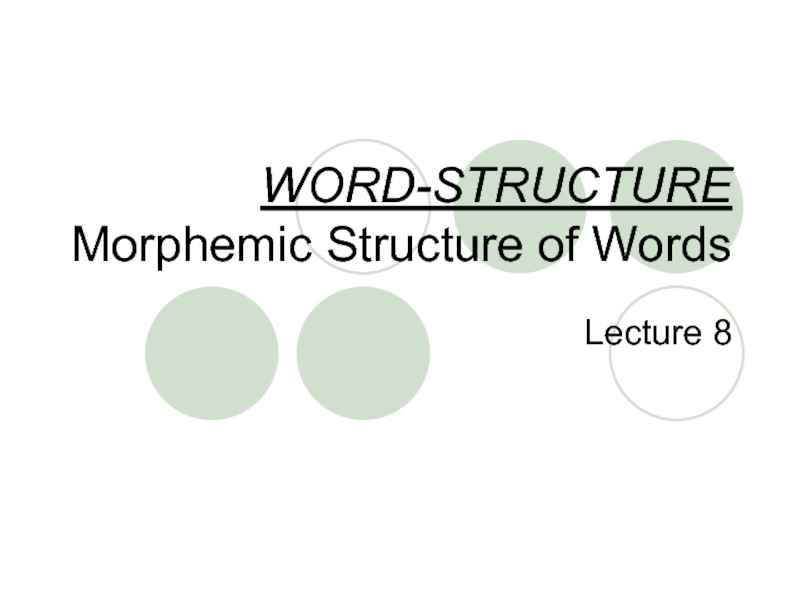
Слайд 21. Word-Structure and Morphemes
Morphe – ‘form’ + -eme. The Greek suffix
– eme has been adopted by linguists to denote the smallest unit (phoneme, sememe, lexeme)
Word-structure is internal organization of words.
The morpheme is the smallest indivisible two-facet language unit.
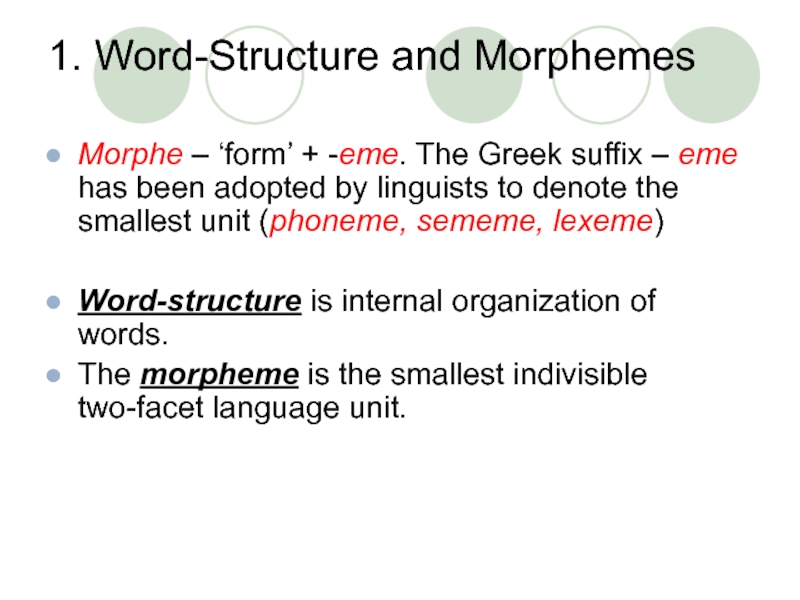
Слайд 3MORPHEMES
Morphemes cannot be segmented into smaller units without losing their constitutive
essence (two-facetedness) – association of a certain meaning with a certain sound-pattern.
Morphemes occur in speech only as constituent parts of words but not independently.
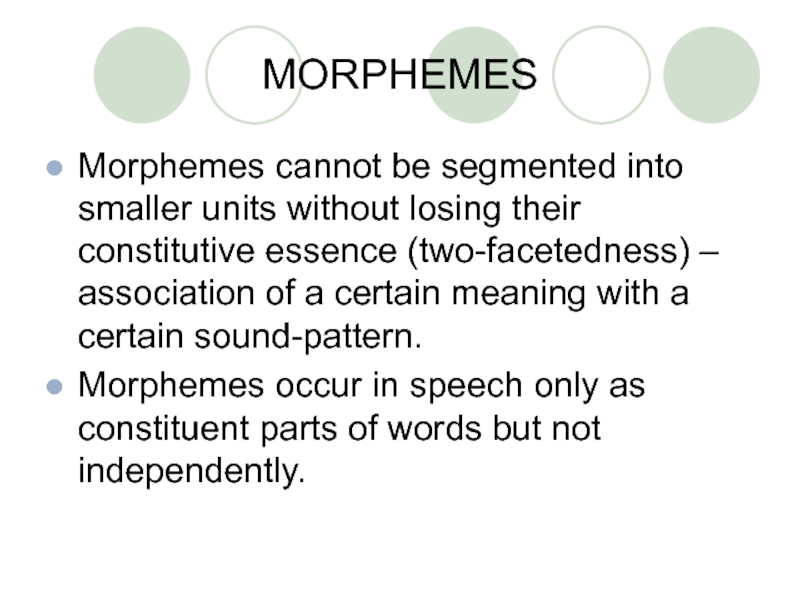
Слайд 4SEGMENTATION OF WORDS
INTO MORPHEMES
Boiler = boil- + er;
Driller = drill-
+ er ;
recurrence of the morpheme -er in these and other similar words and of the morphemes boil- and drill- in
to boil, a boil, boiling and
to drill, a drill, drilling, a drill-press, etc.
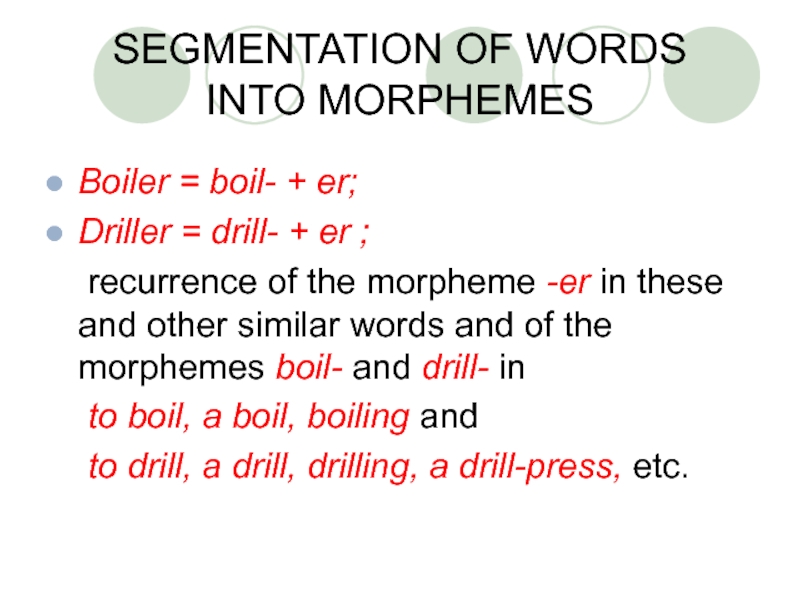
Слайд 5SEGMENTATION OF WORDS
INTO MORPHEMES
flower-pot = flower- + -pot;
shoe-lace = shoe-
+ -lace;
Like a word a morpheme is a two-facet language unit, an association of a certain meaning with a certain sound-pattern.
Unlike a word a morpheme is not an autonomous unit and can occur in speech only as a constituent part of the word.
Lace [l], [ei] ,[s] — without meaning.
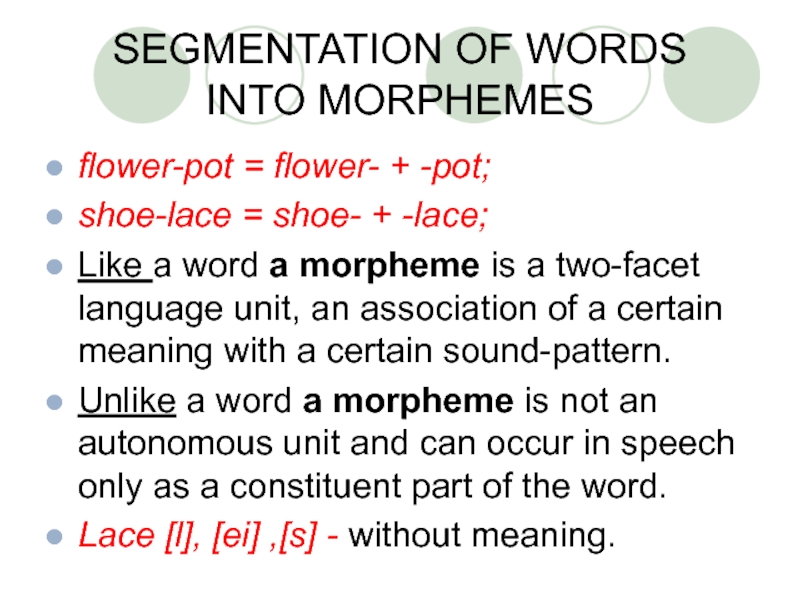
Слайд 6Word-cluster
please pleasing pleasure pleasant
[pli:z] [pli:z] [pleʒ] [plez]
All the representations of the given morpheme that manifest alteration are called allomorphs of that morpheme or morpheme variants.
Thus, [pli:z], [plez] and [рlеʒ] are allomorphs of оnе and the same morpheme.
![Morphemic Structure of Words Word-cluster please pleasing pleasure pleasant [pli:z] [pli:z] Word-cluster please pleasing pleasure pleasant [pli:z]](https://thepresentation.ru/img/tmb/5/464272/1cba0a55ad15a9af6716368ccd8273bb-800x.jpg)
Слайд 7The root-morphemes
in the word-clusters
Duke [dju:k], ducal [‘dju:kl],
duchess [‘d˄tʃiƨ], duchy
[‘d˄tʃi]
or
Poor [puə] , poverty [‘povəti] —
are the allomorphs of one morpheme
![Morphemic Structure of Words The root-morphemes in the word-clustersDuke [dju:k], ducal ['dju:kl], duchess [‘d˄tʃiƨ], duchy The root-morphemes
in the word-clusters Duke [dju:k], ducal ['dju:kl], duchess [‘d˄tʃiƨ], duchy [‘d˄tʃi] or Poor](https://thepresentation.ru/img/tmb/5/464272/fa6410c66ad1e39ef95b89eb4db1e019-800x.jpg)
Слайд 82.1. Semantic Classification of Morphemes
Root-morphemes (radicals) — the lexical nucleus of
words, which has an individual lexical meaning shared by no other morpheme of the language:
Helpless, handy, rewrite, hopeful, disorder
Help- hand- -write hope- -order
The root-morpheme is isolated as the morpheme common to a set of words making up a word-cluster:
work- in to work, worker, working or
theor- in theory, theorist, theoretical, etc.
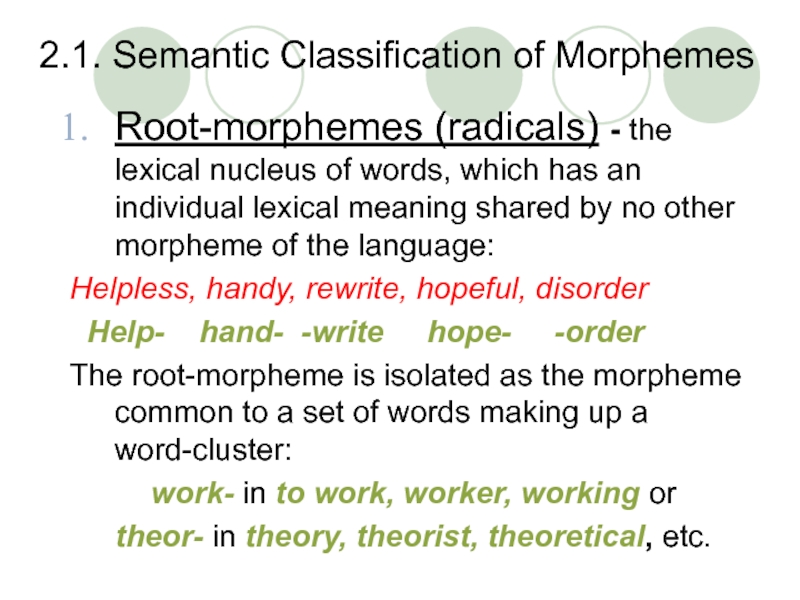
Слайд 9Non-root morphemes
Non-root morphemes include inflectional morphemes (inflections) and affixational morphemes (affixes).
Inflections carry only grammatical meaning.
Lexicology is concerned only with affixational morphemes.
A prefix: understand – mis-understand, correct – in-correct).
A suffix: (-en, -y, -less in heart-en heart-y, heart-less).
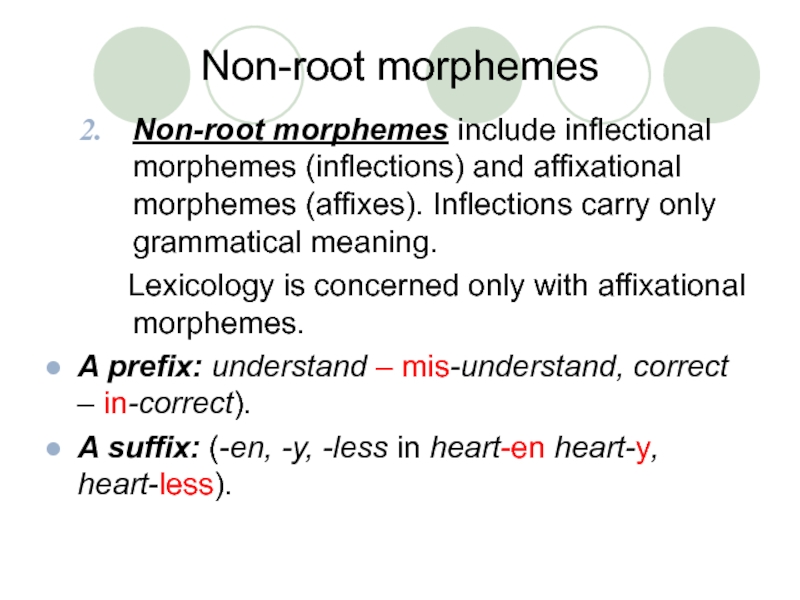
Слайд 102.2. Structural Classification of Morphemes
A free morpheme — one that coincides
with the stem or a word-form. Many root-morphemes are free morphemes, for example, use − of the noun useless is a free morpheme because it coincides with one of the forms of the noun use.
A bound morpheme — a morpheme that must be attached to another element. It occurs only as a constituent part of a word. Affixes are bound morphemes for they always make part of a word, for example:-ness, -ship in the words kind-ness, friend-ship; un-, dis- in the words un-tidy, dis-like.
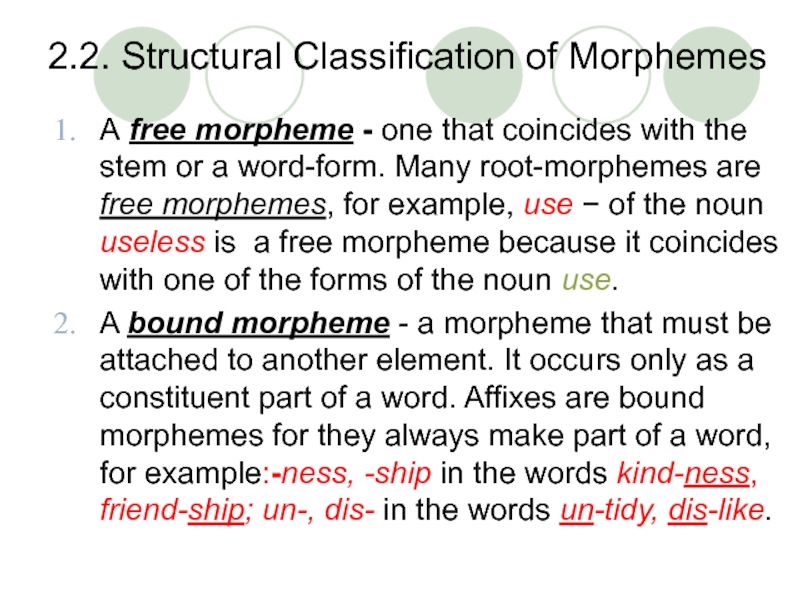
Слайд 11All unique roots and pseudo-roots are-bound morphemes.
Such are the root-morphemes
theor- in theory, theoretical, etc.,
barbar-in barbarism, barbarian, etc.,
-ceive in conceive, perceive, etc.
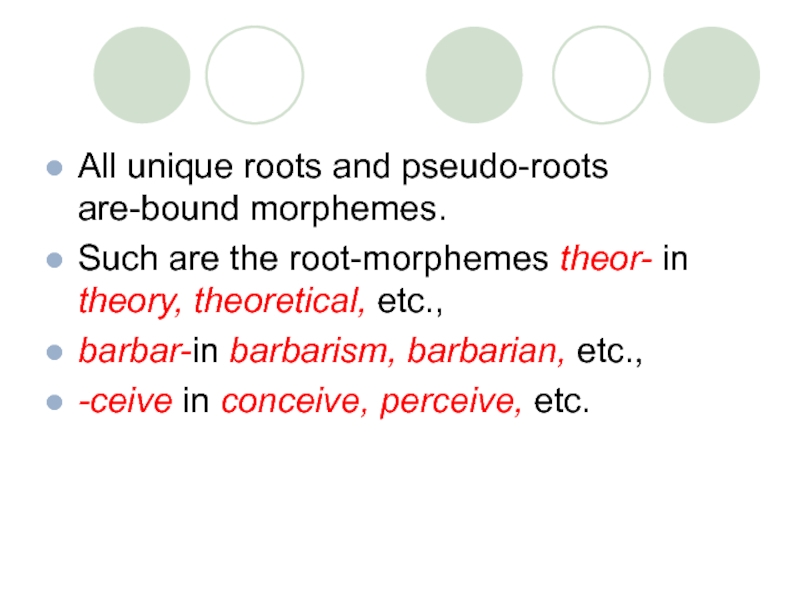
Слайд 12Semi-bound (semi-free) morphemes -morphemes that can function in a morphemic sequence
both as an affix and as a free morpheme: the morpheme well and half can occur as free morphemes: sing well, half a month.
They can also occur as bound morphemes in words like well-known, half-eaten, half-done.
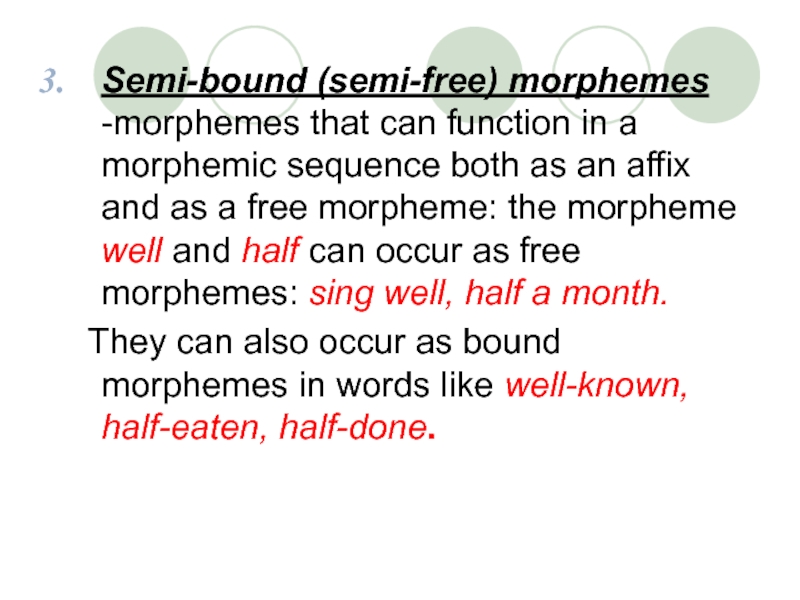
Слайд 13The relationship between the two classifications of morphemes

Слайд 14Word-structure
on the morphemic level:
1st Group — Combining forms are morphemes
borrowed namely from Greek or Latin in which they exist as free forms. They are considered to be bound roots: tele-phone consists of two bound roots.
Phonoscope = ‘sound’ + ‘seeing’;
Microscope = ‘smallness’ + ‘seeing’;
Telegraph = ‘far’ + ‘writing’;
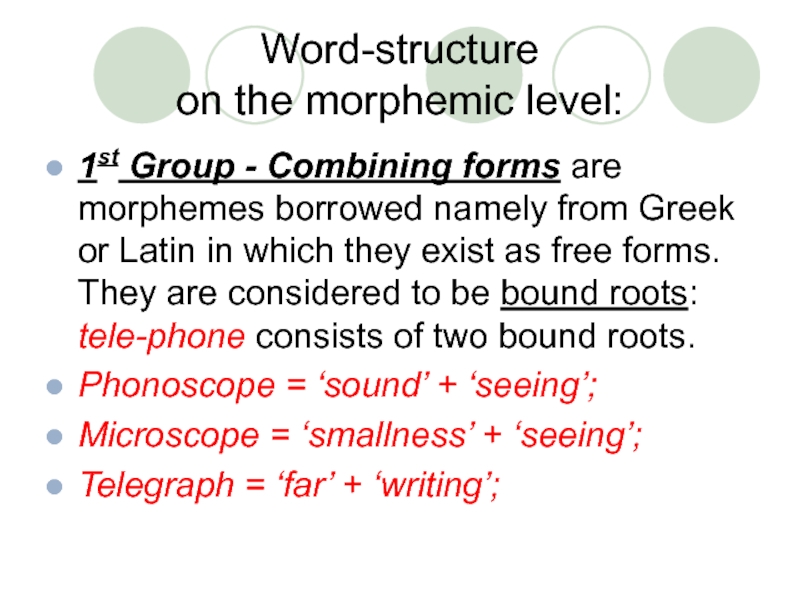
Слайд 15The 2nd Group embraces morphemes occupying a kind of intermediate position,
morphemes that are changing their class membership.
Root morpheme man – in postman, fisherman, gentleman, etc. in comparison with man-made, man-servant.
-man = -er; in cabman, chairman, tradesman
Not a male adult But agent!
* She is an Englishman
*All women are tradesmen.
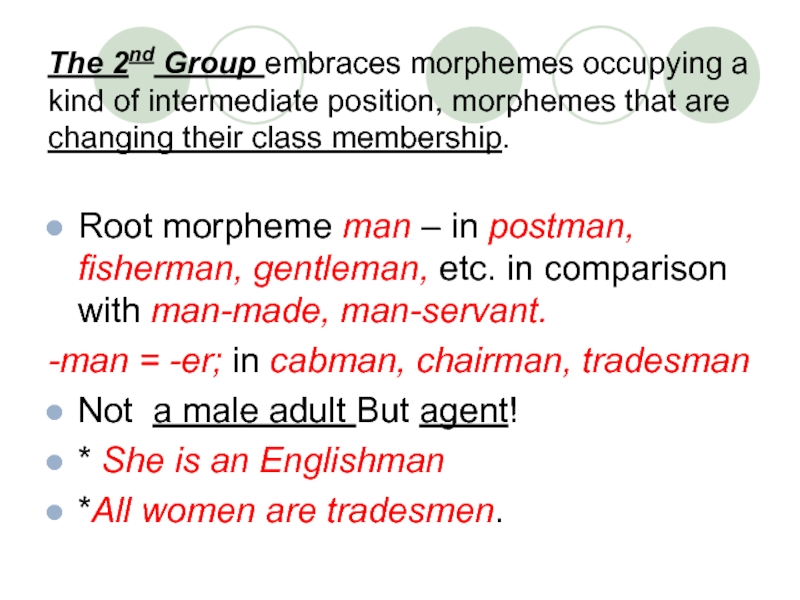
Слайд 163. TYPES OF MEANING IN MORPHEMES
In morphemes can be singled out
different types of meaning depending on the semantic class they belong to.
Root-morphemes have lexical, differential and distributional types of meaning.
Affixational morphemes have lexical, part of-speech, differential and distributional types of meaning.
Both root-morphemes and affixational morphemes are devoid of grammatical meaning.
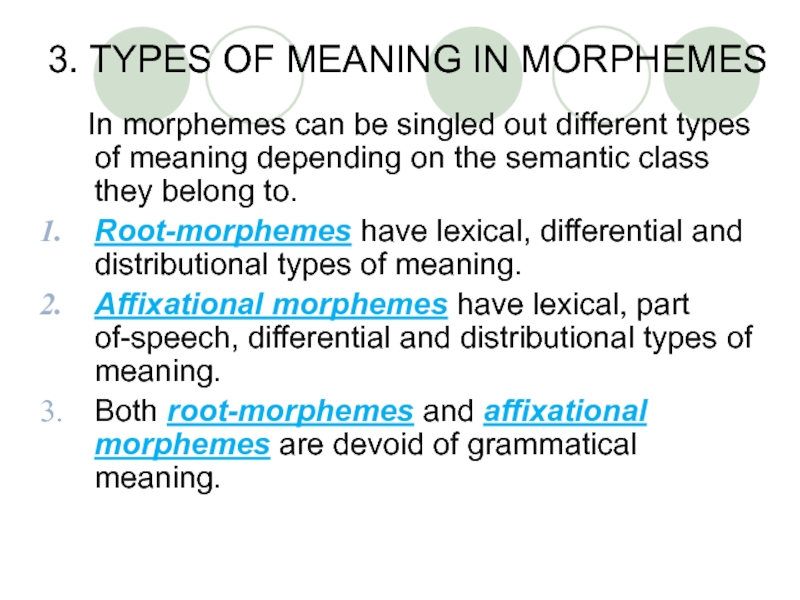
Слайд 173.1. LEXICAL MEANING
Root-morphemes have an individual lexical meaning shared by no
other morphemes in the language: light, deaf, deep, etc.
Affixational morphemes have a more generalizing character of lexical meaning: the suffix –en carries the meaning “the change of a quality”, e.g. to lighten – to become lighter, to deafen – to make somebody deaf.
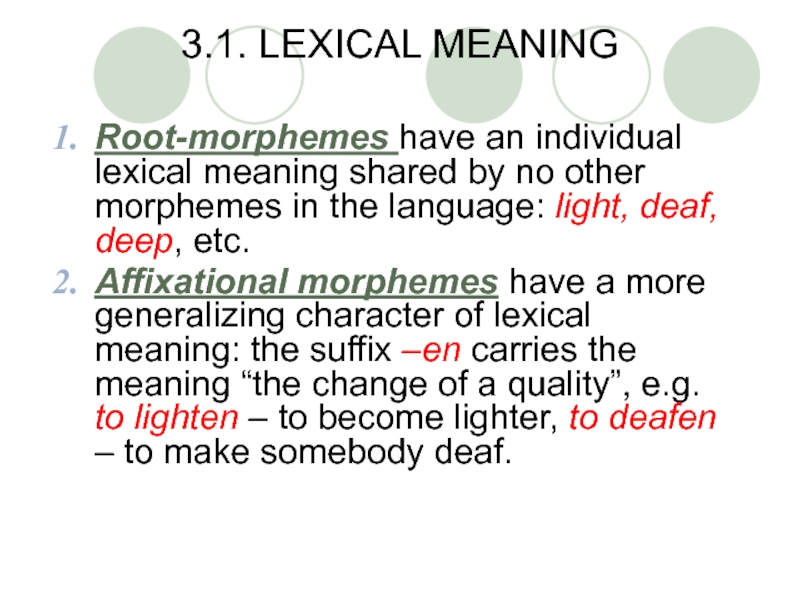
Слайд 18Morphemes may be also analyzed into denotational and connotational components:
The
connotational component of meaning may be found in affixational morphemes: -ette (kitchenette); -ie (dearie, girlie); -ling (duckling) bear a heavy emotive charge.
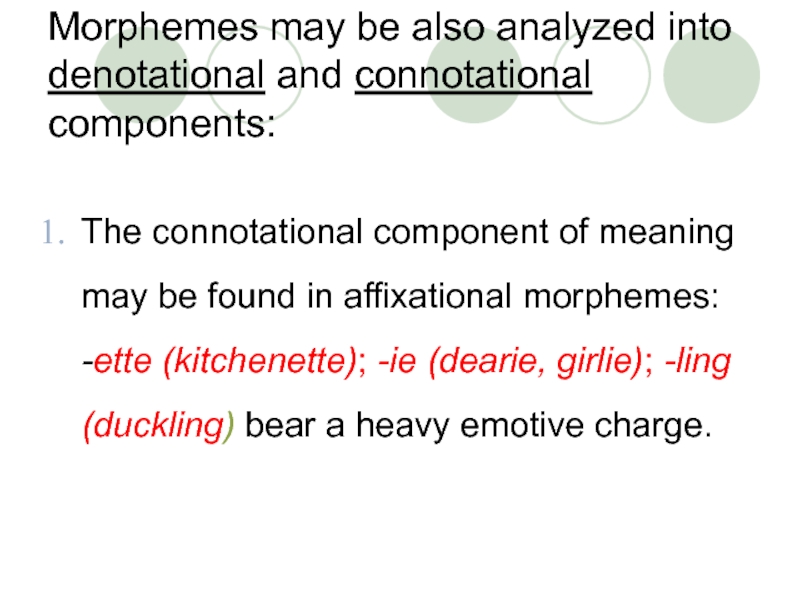
Слайд 19The affixational morphemes with the same denotational meaning sometimes differ only
in connotation: the morphemes –ly, –like, -ish in the words womanly, womanlike, womanish have the same denotational meaning of similarity but differ in the connotational component (женственный – женский – бабий).
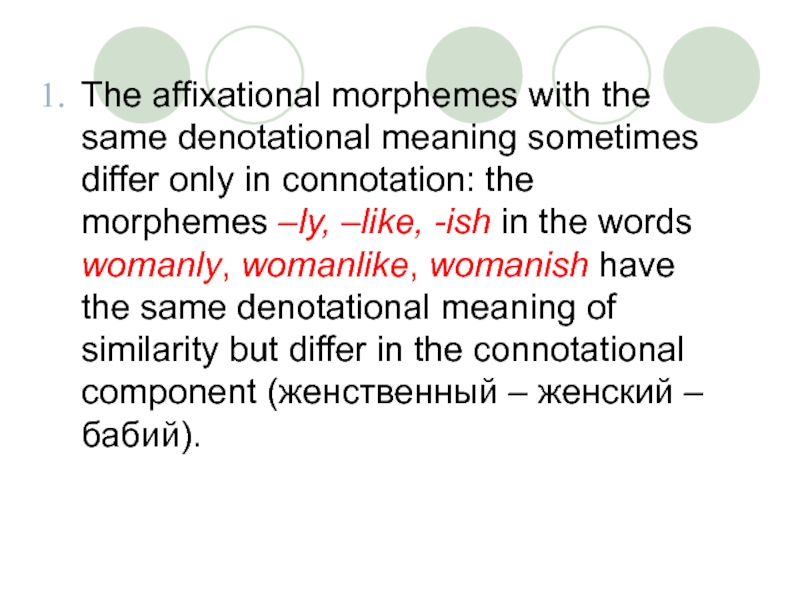
Слайд 20Stylistic reference may be found in morphemes of different types: the
affixational morphemes –
-ine (chlorine), -oid (rhomboid)
are bookish.
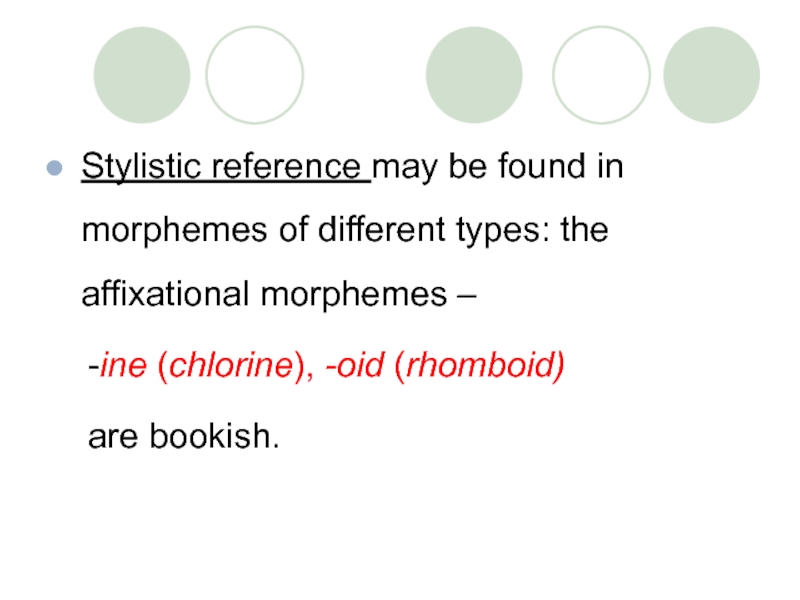
Слайд 213.2. DIFFERENTIAL MEANING
Differential meaning is the semantic component that serves to
distinguish one word from all others containing identical morphemes. In words consisting of two or more morphemes, one of the constituent morphemes always has differential meaning: in the word forehead the morpheme – head serves to distinguish the word from other words containing the morpheme fore-: forefoot, forepart, foreground.
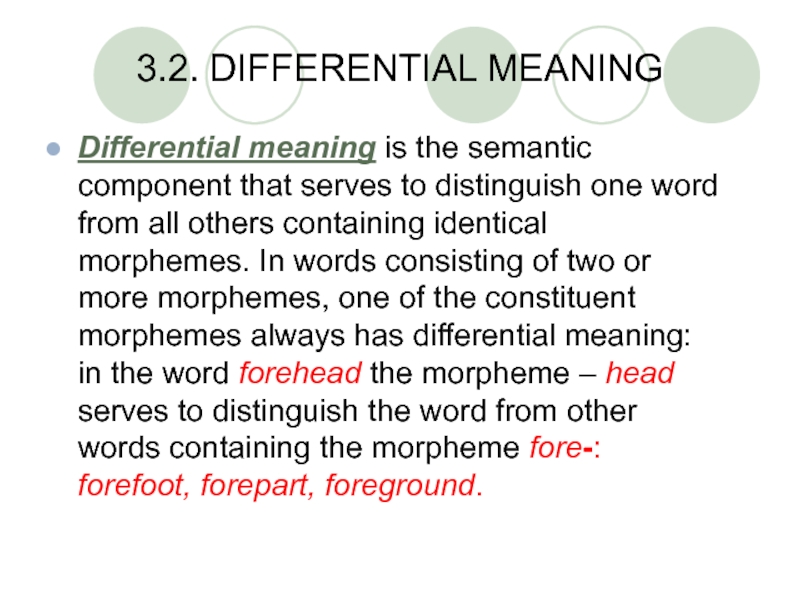
Слайд 223.2. DISTRIBUTIONAL MEANING
Distributional meaning is the meaning of the order and
arrangement of morphemes making up the word.
It is found in all words containing more than one morpheme: the word teacher is composed of two morphemes teach- and –er both of which possess the denotational meaning ‘to help students to learn something’ and ‘the doer of the action’.
A different arrangement of the same morphemes *erteach would make the word meaningless.
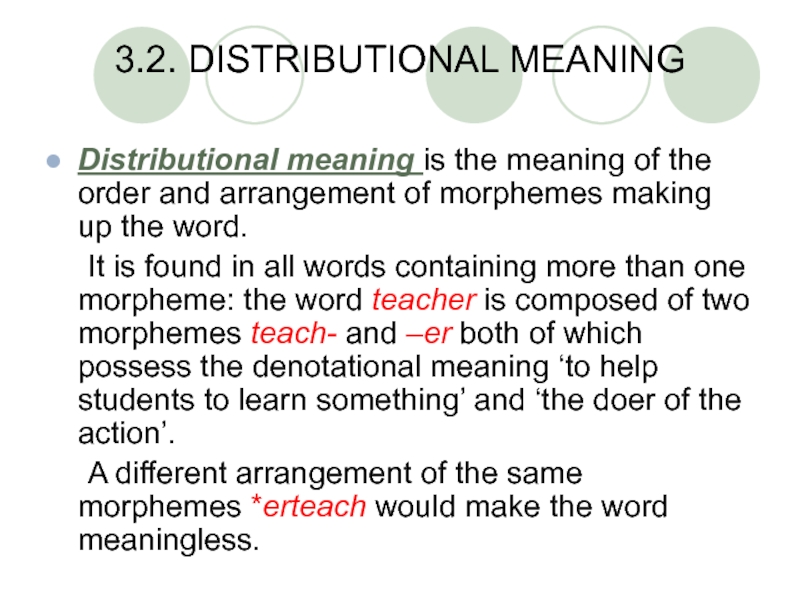
Слайд 233.4. PART-OF-SPEECH MEANING
Part-of-speech meaning is the indicative of the part of
speech to which a derivational word belongs: the affixational morpheme – ness (darkness) is used to form nouns, while the affixational morpheme –less (careless) forms adjectives.
Sometimes the part-of-speech meaning of morphemes predominates: the morpheme –ice in the word justice serves principally to transfer the part-of-speech meaning of the morpheme just- into another class and namely that of the noun.
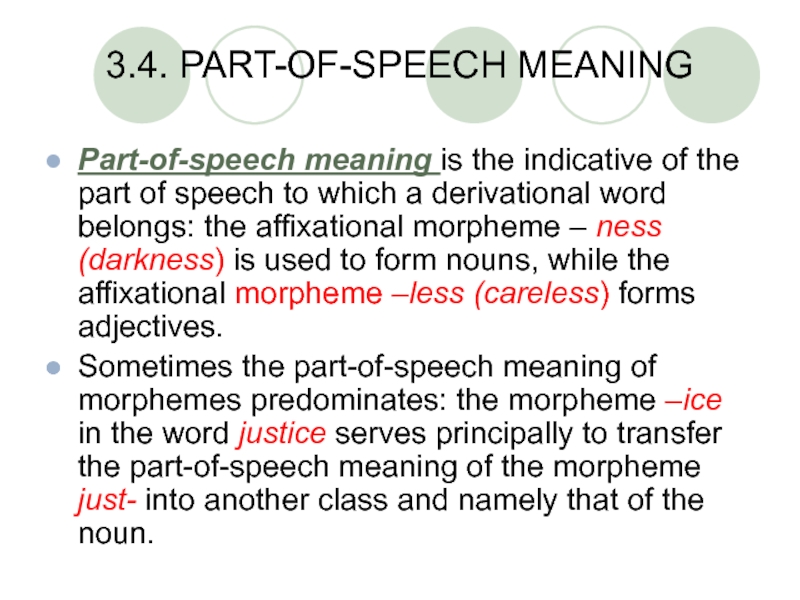
Слайд 244. MORPHEMIC TYPES OF WORDS
According to the number of morphemes words
are classified into monomorphic (root-words) and polymorphic words.
Monomorphic or root-words consist of only one root-morpheme: small, dog, make, put, doll, pen, ect.
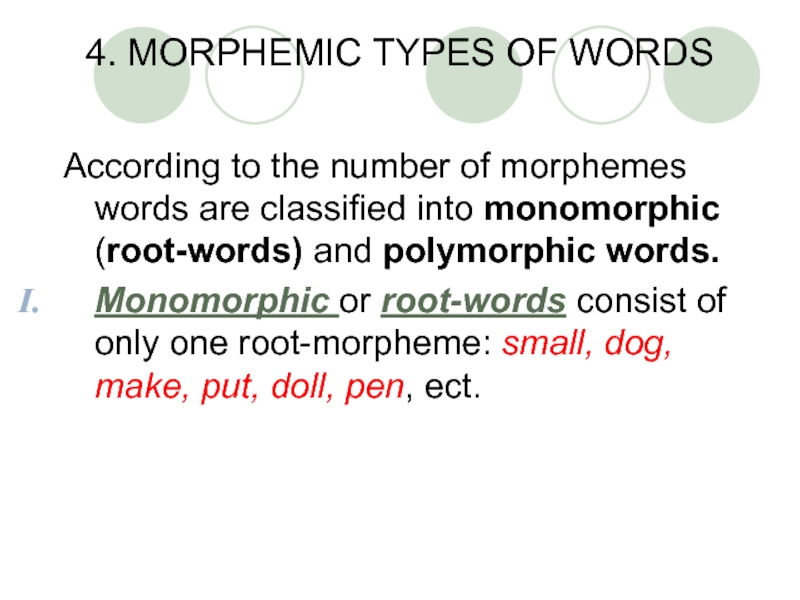
Слайд 25Polymorphic words according to the number of root-morphemes are classified into:
Monoradical words (having one-root morpheme) fall into three subtypes:
radical-suffixal words, i.e. words consisting of one root-morpheme and two or more suffixal morphemes, for example, respectable, respectability;
radical-prefixal words, i.e. words consisting of one root-morpheme and a prefixal morpheme, for example, overcome, unbutton;
prefixo-radical-suffixal words, i.e. words which consist of one root, prefixal and suffixal morphemes (e.g. unforgettable, misinterpretation).
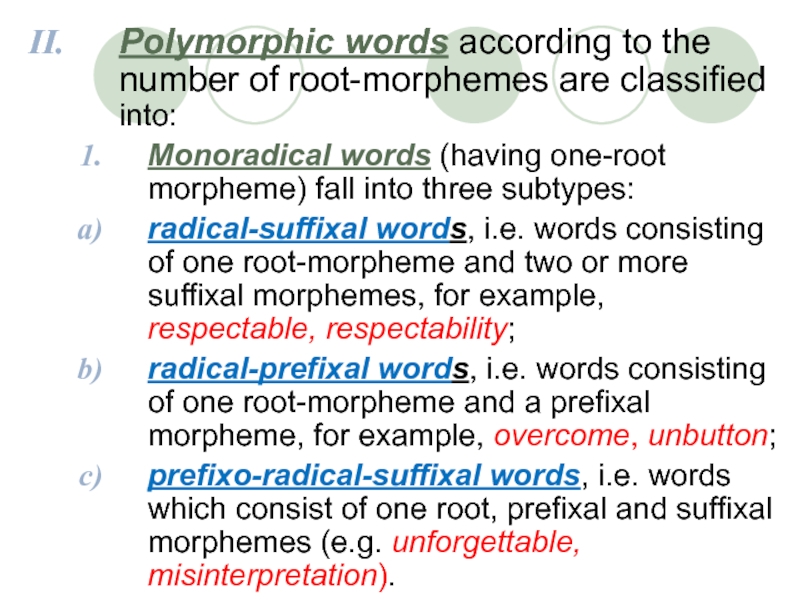
Слайд 26Polyradical words (having words consisting of two or more roots) fall
into two subtypes:
polyradical words which consist of two or more roots with no affixational morpheme, for example, pen-friend, copybook;
polyradical words which contain at least two roots and one or more affixational morpheme, for instance, safety-pin, light-mindedness, pen-holder.
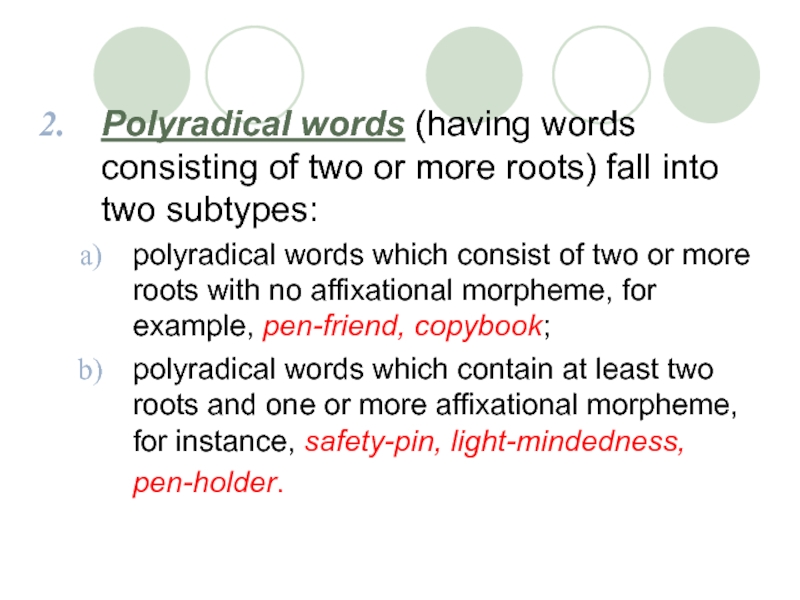
Слайд 275. TYPES OF WORD-SEGMENTABILITY
Word-segmentability is the division of words into
morphemes.
Three types of morphemic segmentability of words are distinguished:
complete,
conditional,
defective.
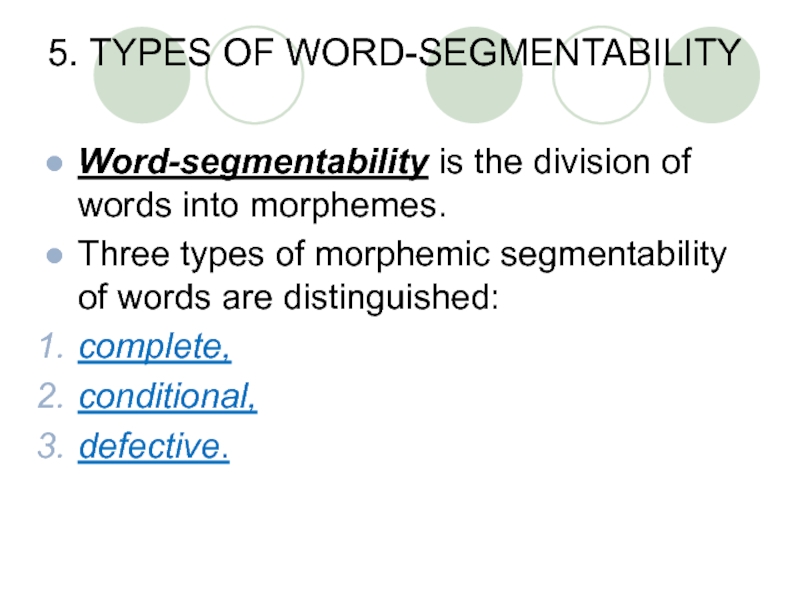
Слайд 285.1. COMPLETE SEGMENTABILITY
Complete segmentability
is characteristic of words, the morphemic structure
of which is transparent enough, as their individual morphemes clearly stand out within the word and can be easily isolated.
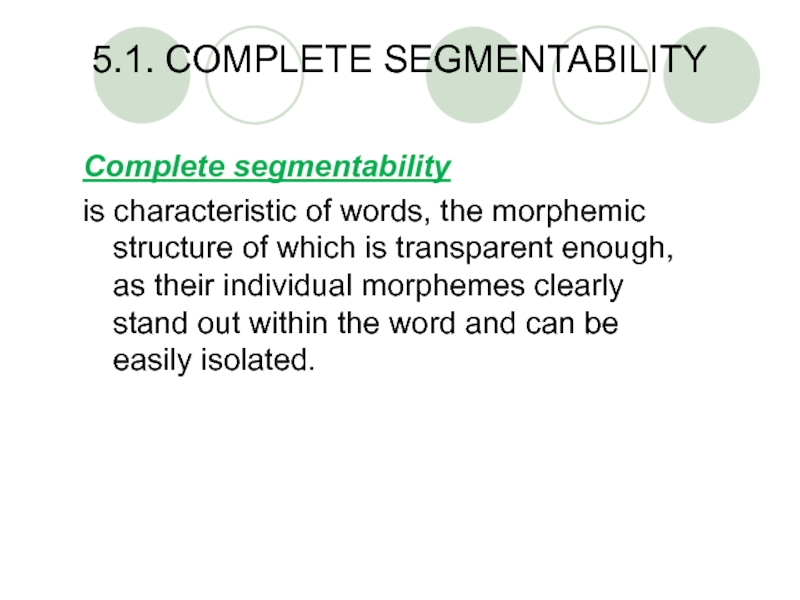
Слайд 29The morphemes making up words of complete segmentability are called morpheme
proper or full morphemes
The transparent morphemic structure of the segmentable words careless, stressful is conditioned by the fact that their constituent morpheme recur with the same meaning in other words: thoughtful, powerful.
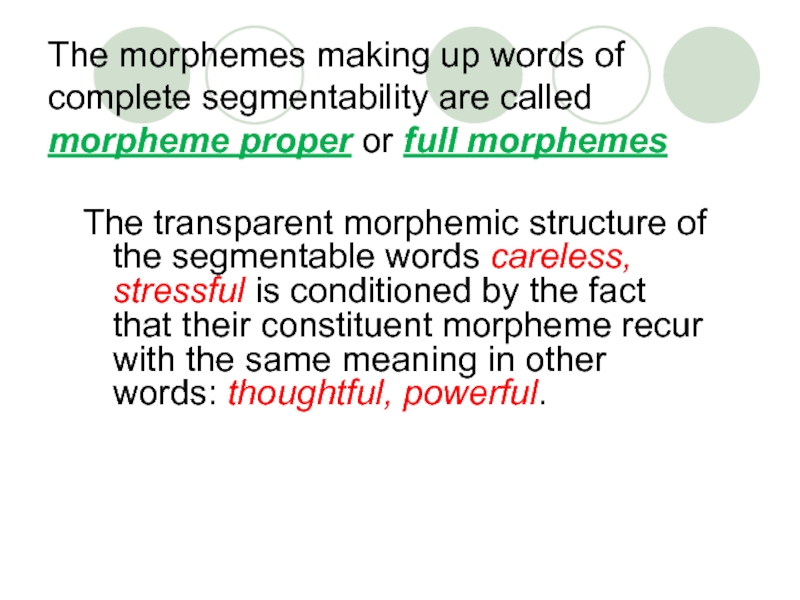
Слайд 305.2. CONDITIONAL SEGMENTSBILITY
Conditional segmentability characterizes words whose segmentation into the constituent
morphemes is doubtful for semantic reasons.
In the words retain, detain or deceive the sound-cluster – [ri-], [di-] seem to be singled out easily due to their recurrence in a number of words (cf. rewrite, reorganize, decode, deorganize).
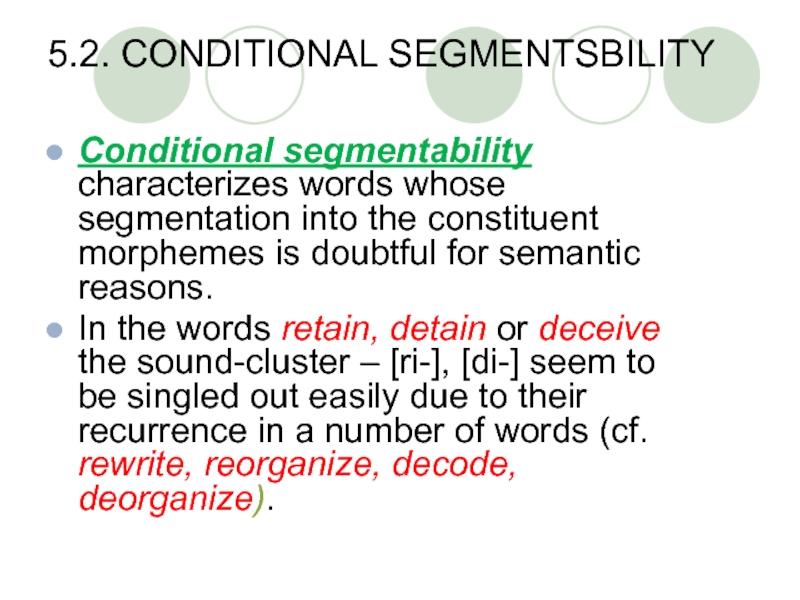
Слайд 31Neither [ri-], [di-] nor [-tain], [si:v] possess any lexical or part-of-speech
meaning of their own.
They have differential and distributional meanings: the [ri-] distinguishes retain from detain and the [-tein] distinguishes retain from receive, whereas their order and arrangement point to the status of the re-, de- as different from that of the –tain and –ceive within the structure of the words.
![Morphemic Structure of Words Neither [ri-], [di-] nor [-tain], [si:v] possess any lexical or part-of-speech Neither [ri-], [di-] nor [-tain], [si:v] possess any lexical or part-of-speech meaning of their own.](https://thepresentation.ru/img/tmb/5/464272/167acbe9fbb5bd366cfd39e2644d46bb-800x.jpg)
Слайд 32The morphemes making up words of conditional segmentability do not rise
to the status of full morphemes for semantic reason and that is why are called pseudo-morphemes or
quasi-morphemes.
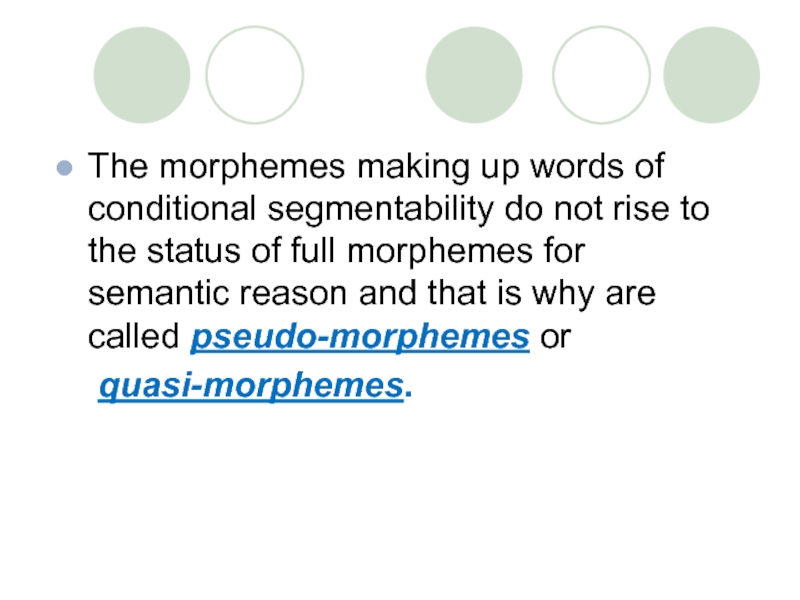
Слайд 335.3. DEFECTIVE SEGMENTABILITY
Defective segmentability is the property of words whose component
morphemes seldom or never recur in other words.
One of the component morphemes of these words is a unique morpheme, which is isolated and understood as meaningful because the constituent morphemes display a more or less clear denotational meaning.
In streamlet, ringlet, leaflet the morpheme –let has diminutive meaning.
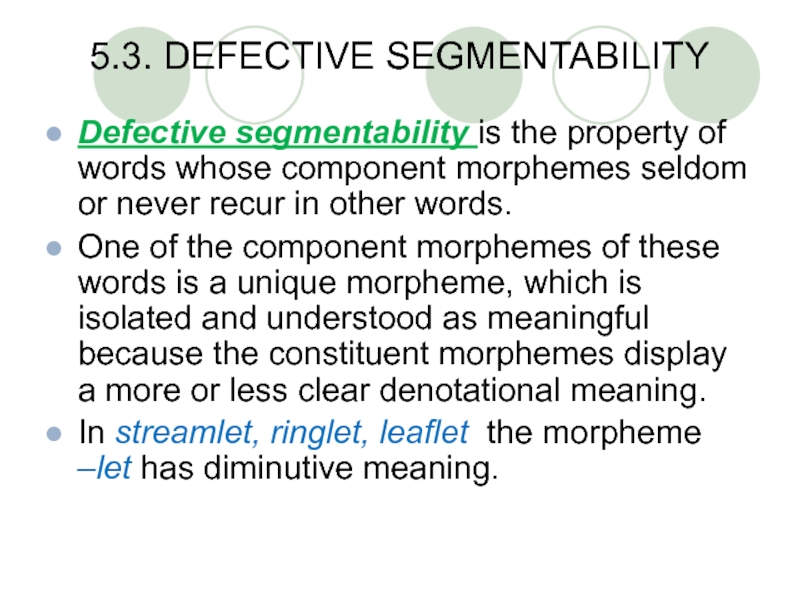
Слайд 34In the word hamlet the morpheme -let has the meaning of
diminutiveness. This morpheme occurs in the words ringlet, leaflet, streamlet.
The sound-cluster [hæm-] does not recur in any other English word.
The morpheme ham- carries a differential and distributional meaning as it distinguishes hamlet from streamlet, ringlet.
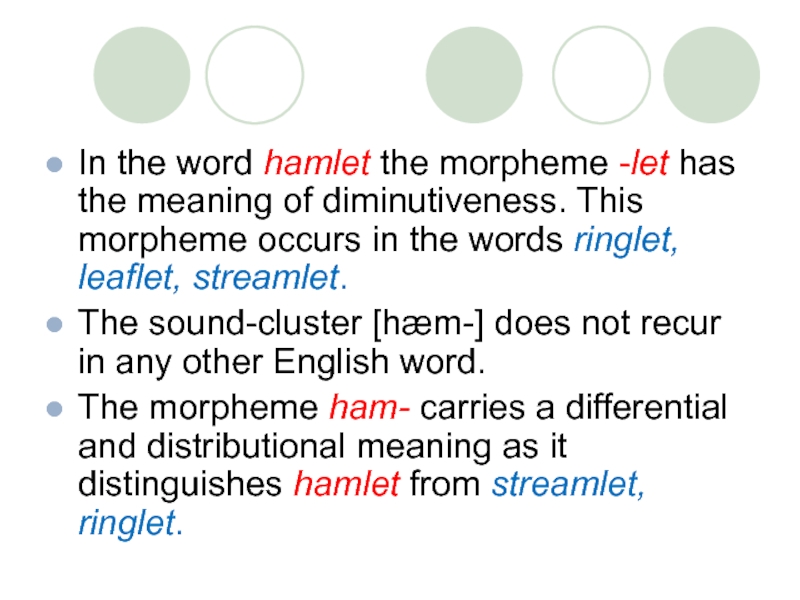
Слайд 35comparison with words
locket, lionet, cellaret, etc. leads one to the
isolation of the morpheme -et having a diminutive meaning, the more so that the morphemes lock-, lion-, cellar-, etc. recur in other words: (cf. lock, locky; lion, lioness; cellar, cellarage).
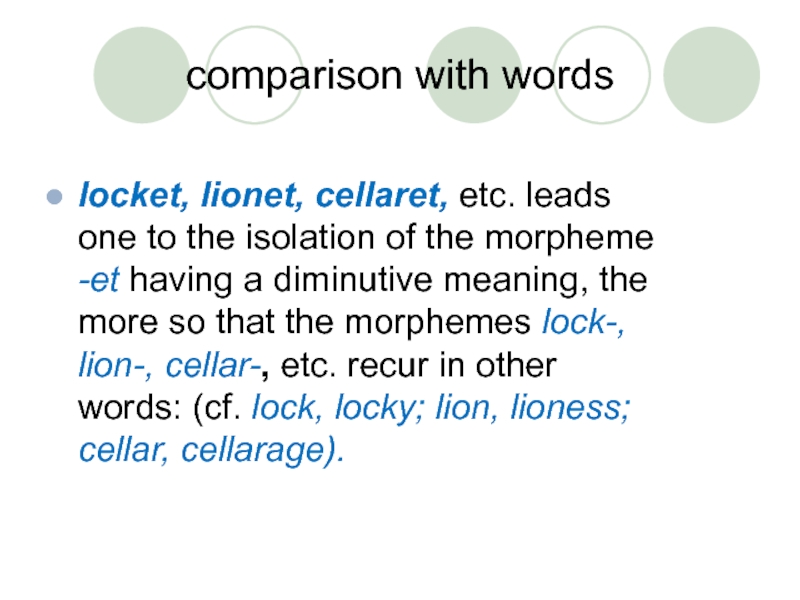
Слайд 36The isolation of the morpheme -et leaves in the word pocket
the sound-cluster [роk] that does not occur in any other word of Modern English.
The morpheme [роk] clearly carries a differential and distributional meaning as it distinguishes pocket from the words mentioned above and thus must be qualified as a unique morpheme.
![Morphemic Structure of Words The isolation of the morpheme -et leaves in the word pocket The isolation of the morpheme -et leaves in the word pocket the sound-cluster [роk] that does not](https://thepresentation.ru/img/tmb/5/464272/b502e851df1674962702a75c019e4bb7-800x.jpg)
Слайд 37The morphemic analysis of words like
cranberry, gooseberry, strawberry shows that
they also possess defective morphemic segmentability: the morphemes cran-, goose-, straw- are unique morphemes.
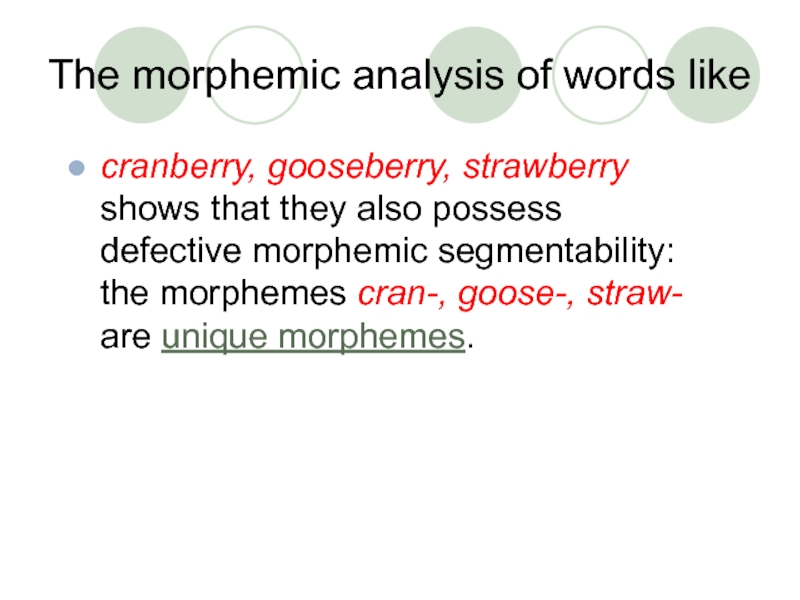
Слайд 38on the level of morphemic analysis
the linguist has to operate
with two types of elementary units, namely full morphemes and pseudo-(quasi-)morphemes.
A considerable percentage of words of conditional and defective segmentability signals a relatively complex character of the morphological system of the language, reveals the existence of various heterogeneous layers in its vocabulary.
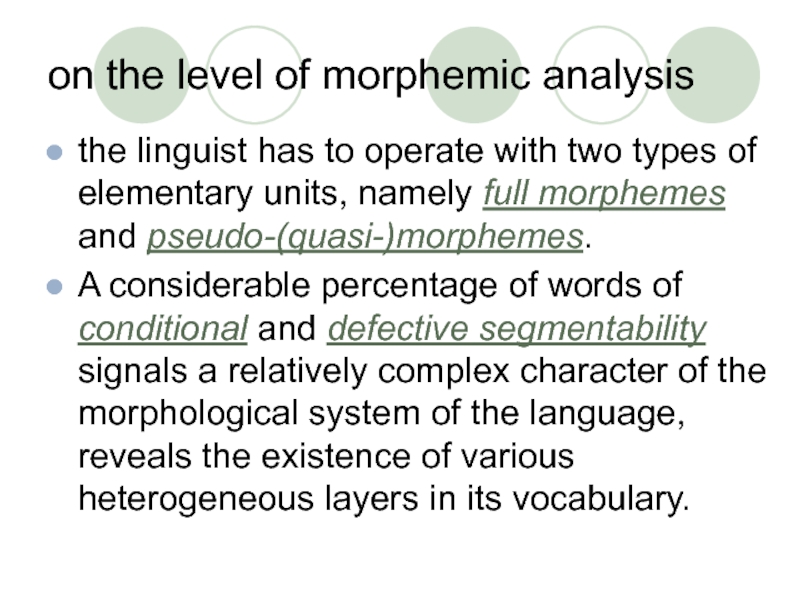
Слайд 397. PROCEDURE OF MORPHEMIC ANALYSIS
The procedure of segmenting words into the
constituent morphemes is known as the method of Immediate and Ultimate Constituents (any of two meaningful parts forming a larger linguistic unit. L. Bloomfield).
It is based on a binary principle, i.e. each stage of the procedure involves two components the word immediately breaks into.

Слайд 40At each stage these two components are referred to as the
Immediate constituents (ICs). Each IC at the next stage of analysis is broken into smaller meaningful elements.
The analysis is completed when constituents are incapable of further division, i.e. morphemes.
These morphemes are referred to as the Ultimate Constituents (UCs).
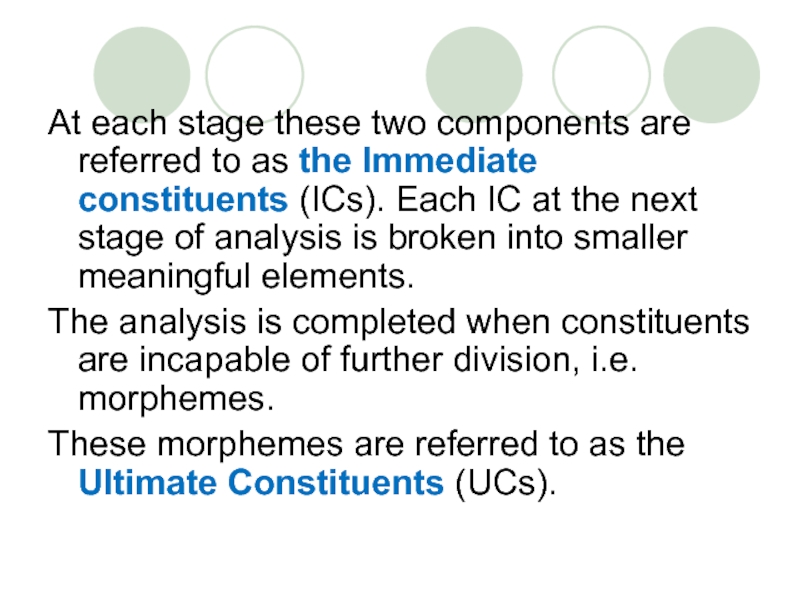
Слайд 41The noun friendliness is first segmented into the ICs:
friendly- (recurring
in the adjectives friendly and friendly-looking).
–ness (found in a countless number of nouns): happiness, darkness.
The IC –ness is at the same time an UC of the noun, as it cannot be broken into any smaller elements possessing both sound-form and meaning.
The IC friendly- is next broken into the ICs
friend- (recurring in friendship, unfriendly) and
–ly (recurring in wifely, brotherly).
The ICs friend- and –ly are both UCs of the word under analysis.
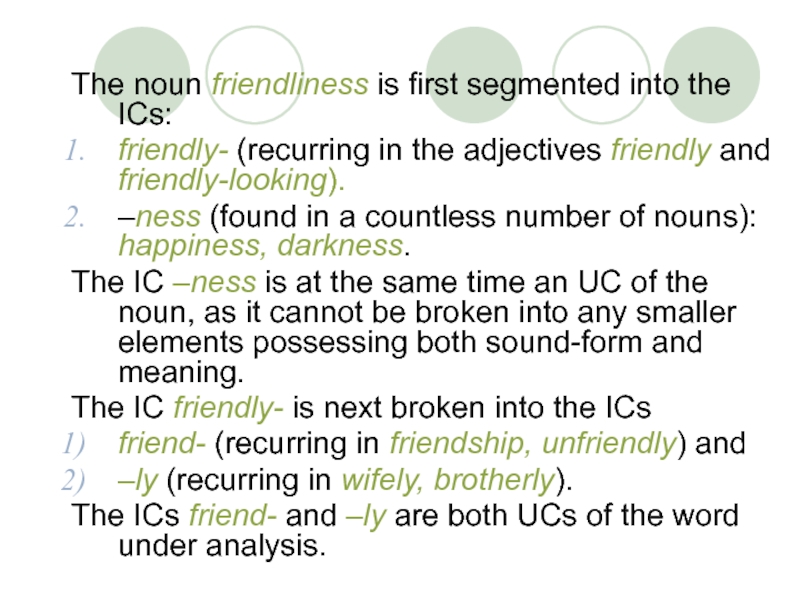
Слайд 42The procedure of segmenting a word into its Ultimate Constituent morphemes
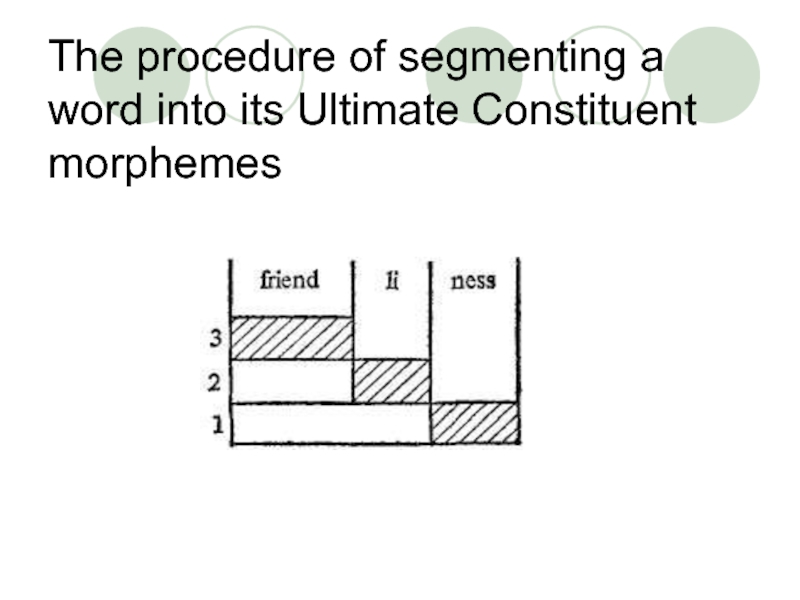
Слайд 438. PRINCIPLES OF WORD-SEGMENTATION
According to the affix principle the segmentation of
the word into its constituent morphemes is based on the identification of an affixational morpheme within a set of words, for example, the identification of the morphemes –less leads to the segmentation of words like thoughtless, careless, merciless into the suffixational morpheme –less and the root-morphemes thought-, care-, merci- within a word-cluster.
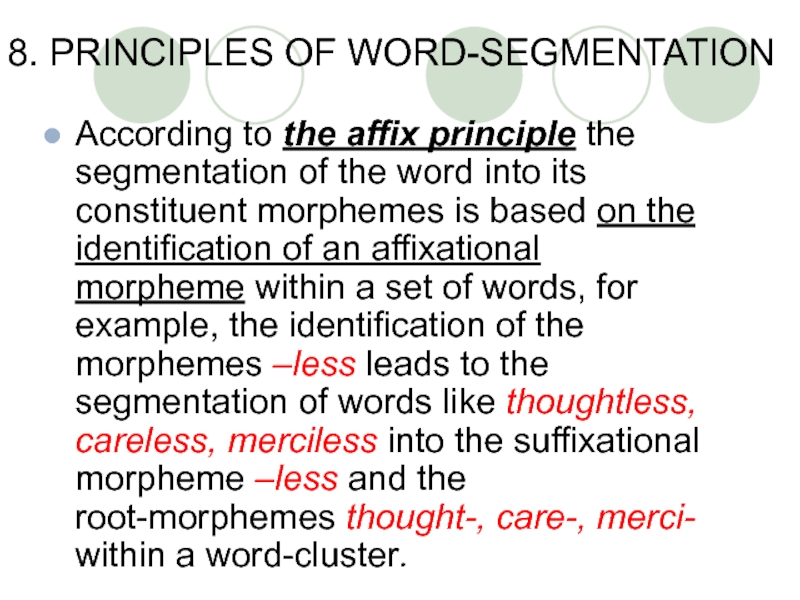
Слайд 44According to the root principle the identification of the root-morpheme agree-
in the words agreeable, agreement, disagree makes it possible to split these words into the root agree- and the affixational morphemes -able, -ment, dis-.
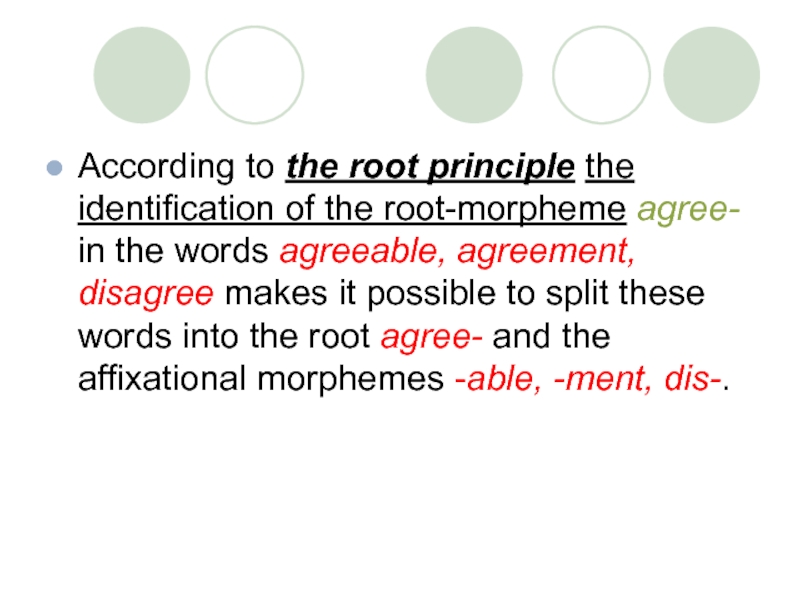
Слайд 45Summary and Conclusions:
There are two levels of approach to the study
of word-structure: the level of morphemic analysis and the level of derivational or word-formation analysis.
The basic unit of the morphemic level is the morpheme defined as the smallest indivisible two-facet language unit.
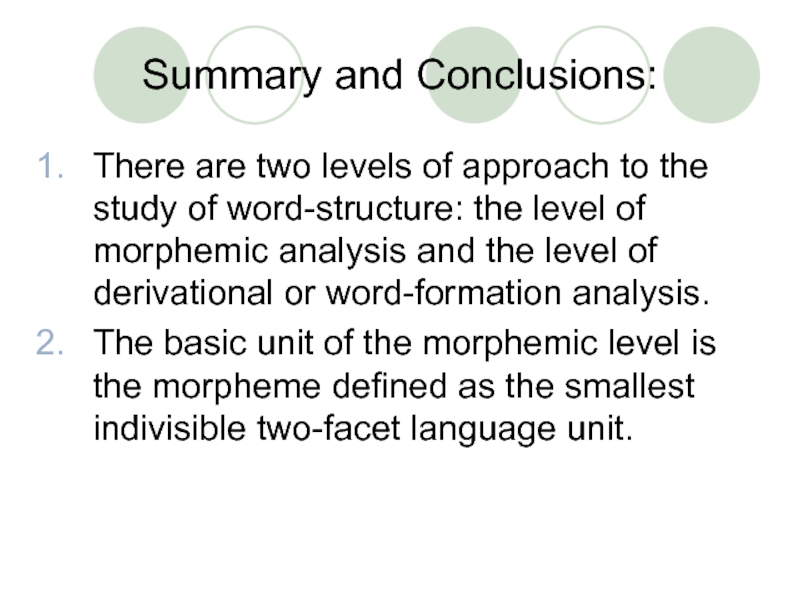
Слайд 46Summary and Conclusions:
Three types of morphemic segmentability of words are distinguished
in linguistic literature: complete, conditional and defective. Words of conditional and defective segmentability are made up of full morphemes and pseudo (quasi) morphemes. The latter do not rise to the status of full morphemes either for semantic reasons or because of their unique distribution.
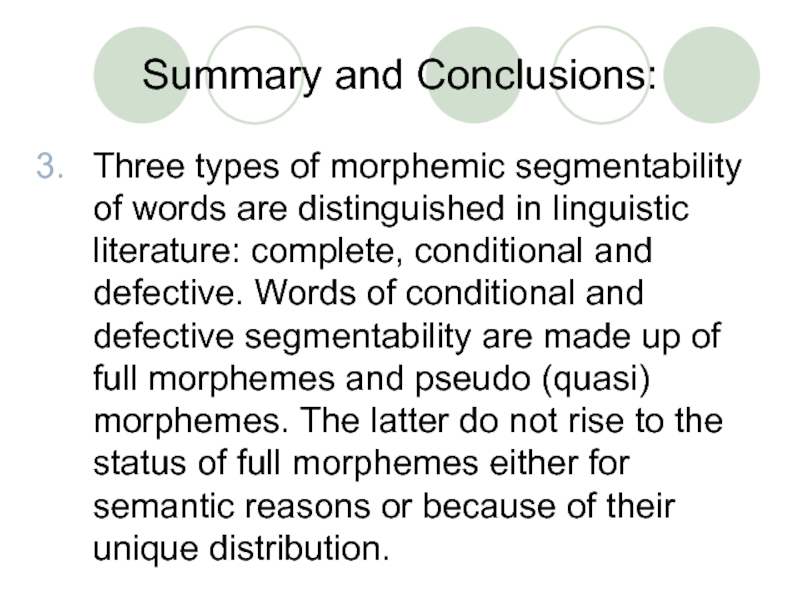
Слайд 47Summary and Conclusions:
Semantically morphemes fall into root-morphemes and affixational morphemes (prefixes
and suffixes); structurally into free, bound and semi-free (semi-bound) morphemes.
The structural types of words at the morphemic level are described in terms of the number and type of their ICs as monomorphic and polymorphic words.
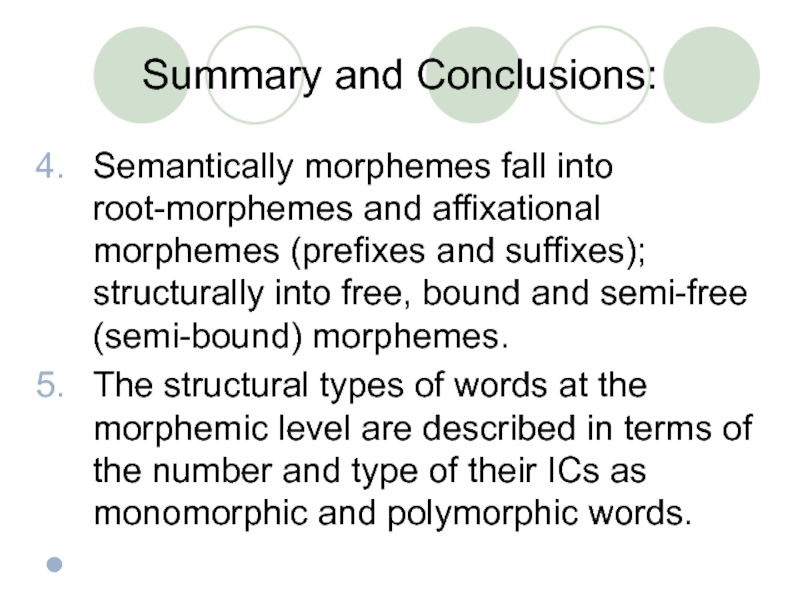
Слайд 48References
Зыкова И.В. Практический курс английской лексикологии. М.: Академия, 2006. – С.
52-56.
Гинзбург Р.З. Лексикология английского языка. М.: Высшая школа, 1979. – С. 89-106.
Антрушина Г.Б., Афанасьева О.В., Морозова Н.Н. Лексикология английского языка. М.: Дрофа, 2006. – С. – 78-128.
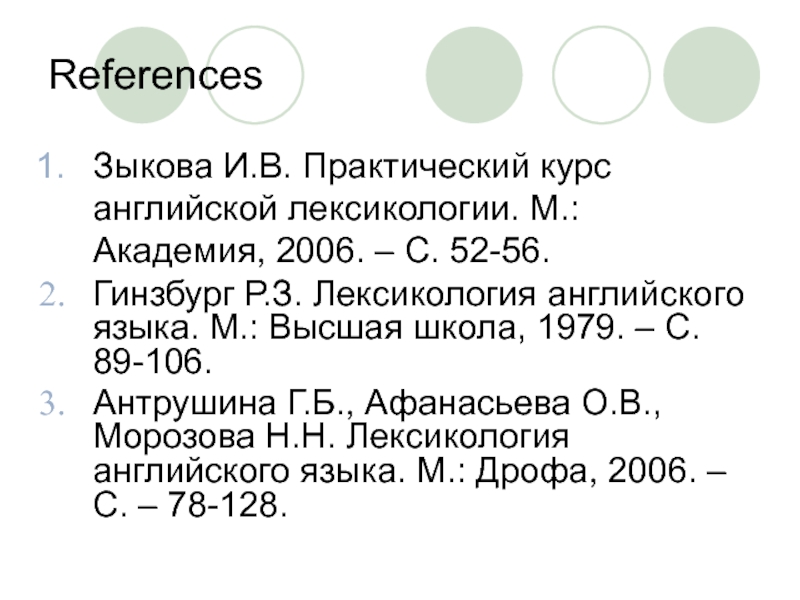
Morphemes. The Structure of the English Word Lecture 2
Morpheme • The morpheme is the smallest meaningful unit of form. • The branch of linguistics which studies morphemes and their arrangement in forming words is called morphology. • Morphemes cannot be segmented into smaller units without losing their constitutive essence. • All the representations of the given morpheme are called allomorphs or morpheme variants (please, pleasing, pleasant, pleasure).
Semantically morphemes fall into two types: • 1) Root-morphemes (or radicals) are the lexical nuclei of words. The root-morpheme is isolated as the morpheme common to a set of words making up a word-cluster, e. g. the morpheme teach- in to teach, teacher, teaching. • 2) Non-root morphemes include inflectional morphemes (or inflections) and affixational morphemes (or affixes).
Types of Morphemes The root expresses the lexical meaning of the word. Affixes modify the meaning of the root. Inflexions build new grammatical forms of the same words. The stem is the part of the word to which the latest suffix is added (it is the part of a word that remains unchanged throughout its paradigm): Active — act (root/stem) + ive (suffix) Activity – activ (stem) + ity (suffix)
Affixes • A prefix is a derivational morpheme preceding the root-morpheme and modifying its meaning (pronounce – mispronounce, safe – unsafe). • A suffix is a derivational morpheme following the root and forming a new derivative in a different part of speech or a different word class (cf. –en, -y, -less, in hearten, hearty, heartless).
Structurally morphemes fall into three types: 1) A free morpheme coincides with the stem or a wordform (boy). 2) A bound morpheme occurs only as a constituent part of the word (darkness, friendship, activize, impolite, demobilize). • Pseudo-roots: gooseberry, conceive • Combining forms: telephone, cyclic 3) Semi-bound (semi-free) morphemes are morphemes that can function in a morphemic sequence both as an affix and as a free morpheme (well and half in sleep well, half an hour; well-known, half-done).
Types of meaning in morphemes Root-morphemes Affixational morphemes • lexical meaning • part-of-speech meaning • differential meaning • distributional meaning
Lexical meaning Denotational and connotational Root-morphemes have an components. individual lexical meaning shared by no other morphemes in the language. Endearing and diminutive suffixes: –ette: kitchenette, leaflet; -ie : dearie, girlie; The lexical meaning of -ling: duckling, wolfling. affixational morphemes is, as a rule, of a more generalizing character. -ly, -like, -ish womanly, womanlike, womanish deepen deafen
Differential meaning is the semantic component that serves to distinguish one word from all others containing identical morphemes. Bookcase Bookstall Bookshelf
Distributional meaning is the meaning of the order and arrangement of morphemes making up the word. Singer *Ersing
Part-of-speech-meaning In most cases affixational morphemes are indicative of the part of speech to which a derivational word belongs. Movement Careless Justice
Morphemic types of words Monomorphic or root-words consist of only one root-morpheme small dog make Polymorphic 1. Monoradical 1) radical-suffixal words acceptable, acceptability 2) radical-prefixal words outdo, unbutton 3) prefix 0 -radical-suffixal words disagreeable, misinterpretation 2. Polyradical 1) book-stand, lamp-shade 2) safety-pin, light-mindedness, penholder
Word-segmentability • Complete segmentability • Conditional segmentability • Defective segmentability
Complete segmentability is characteristic of a great number of words, the morphemic structure of which is transparent enough, as their individual morphemes clearly stand out within the word and can be easily isolated. morphemes proper or full morphemes endless, useless an end, to end; use, to use; nameless, powerless
Conditional segmentabilty characterizes words whose segmentational morphemes is doubtful for semantic reasons. pseudo-morphemes or quasi-morphemes [ri-], [di-] [-tein], [-si: v] retain, detain, receive, deceive rewrite, reorganize, decode, deorganize. retain detain receive
Defective segmentability is the property of words whose component morphemes seldom or never occur in other words. hamlet ringlet, leaflet, streamlet
Procedure of Morphemic Analysis Method of Immediate and Ultimate Constituents. Immediate Constituents are any of the two meaningful parts forming a larger linguistic unit. Friendliness Friendly – ness Friend — ly
Ways of enriching vocabulary • by means of the word-building • by means of changing the meaning of words • by means of forming phraseological units • by means of borrowing new words from other languages
Enriching Vocabulary
Word-building Main ways of word-building • Conversion • Affixation • Composition • Shortening Secondary ways of word-building • Blending (contamination) • Sound interchange • Stress interchange (distinctive stress) • Sound imitation (onomatopoeia) • Back formation (disaffixation)
AFFIXATION Affixation is the formation of words by adding derivational affixes to different types of bases. It has been productive in all periods of the history of English. Affixation includes suffixation and prefixation.
Classification of Suffixes 1. Origin: Romanic (e. g. — age, — ment, — tion), Native (e. g. -er, -dom, — ship), Greek (e. g. -ism, -ize), etc. 2. Productivity: productive suffixes (-er, -ing, -ness, ation, -ee, -ism, -ist, -ance, -ry, -or, -ics), nonproductive suffixes (-some, -th, -hood, -ship, -ful, -ly, -en, — ous). 3. Lexico-grammatical character of the base suffixes are usually added to: deverbial suffixes (speaker, reader, agreement, suitable); denominal suffixes (hopeless, hopeful, violinist, tiresome); deadjectival suffixes (widen, quickly, reddish, loneliness).
4. Part of speech they form: noun-forming suffixes (writer, bondage, knighthood, tenderness, friendship, assistance, freedom, housing); adjective-forming suffixes (readable, normal, phonetic, dependent, shaped, hopeful, whitish, positive, courageous); numeralforming suffixes (sevenfold, fifteen, fifth, forty); verbforming suffixes (activate, intensify, harmonize, establish). 5. Generalizing denotational meaning: agent of an action (baker, assistance); collectivity (officialdom), diminutiveness (girlie, duckling), etc. 6. Stylistic reference: neutral (readable, housing); with stylistic value (positron, asteroid, etc. )
Classification of Prefixes 1. Origin: Native (befool, misunderstand, overestimate, unacademic), Romanic (insufficient), Greek (synthesis). 2. Productivity: productive (e. g. redo, antibiotic). 3. Lexico-grammatical character of the base: deverbal (redo, overdo, outcast); denominal (unbutton, detrain, ex-wife); deadjectival (unpleasant, biannual).
4. Part of speech they from: verb-forming prefixes (enclose, befriend, dethrone); noun-forming prefixes (non-smoker, sub-branch, ex-wife); adjectiveforming prefixes (unjust, illegal, irregular); adverbforming prefixes (unfortunately, uproad). 5. Generalizing denotational meaning: negative prefixes (ungrateful, nonpolitical, insufficient, disloyal, amoral); reversative prefixes (unbutton, demobilize, disconnect); pejorative prefixes (misunderstand, maltreatment, pseudo-scientific); prefixes of time and order (pre-war, post-war); prefix of repetition (rethink); locative prefixes (transatlantic, superstructure). 6. Stylistic reference: neutral (unjust); with stylistic value (superstructure).
QUESTIONS • • • • 1. What are the main ways of enriching vocabulary? 2. What are the principal productive ways of word-building in English? 3. What do we mean by affixation? 4. What is a morpheme? 5. How do we distinguish between a morpheme and a word? 6. What is a suffix? What is a prefix? 7. What are the structural types of words in English? 8. What types of meaning do root morphemes possess? 9. What types of meaning do affixational morphemes have? 10. What are three types of morphemic segmentability? 11. What is the procedure of morphemic analysis based on? 12. What are the principles of classification of suffixes? 13. What are the principles of classification of affixes? 14. What affixes are called native? 15. What are the sources of borrowed affixes?
Ex. 1 • • Analyze the morphological structure of the words in bold; identify the number of morphemes and their types according to the semantic and structural classifications of morphemes: Anxious Conceive Light-mindedness Photographic
Disfellowship the following words from the point of view of their intermediate constituents (ICs) and ultimate cons Unachievable II. Analyse Ex. 2 Analyse the following words from the point of view of their intermediate constituents (ICs) and ultimate constituents (UCs): • Unachievable • Disfellowship
Ex. 3. Segment the following words into morphemes. Define the semantic types and the structural types of morphemes. Beggarly, postman, shorten, destabilize, sympathy, fruitfulness, maltreatment, disaffected, overrule, photographic, half-eaten, theory, rent-free.
Ex. 4 Translate the following words into Russian, taking into account the lexical meaning of the root and affixational morphemes: Eyelet, dehouse, neurosis, hostess, betrayal, antipathy, briefly, horsemanship, prewar, famous.
Ex. 5 Define the morphemes the differential meaning of which helps to distinguish between words in the given sets. 1. notebook, copybook, exercisebook, textbook 2. crossroads, crosswind, cross-current, cross-legged 3. city-based, hospital-based, ocean-based, foreign-based 4. raspberries, elderberries, strawberries, cranberries
Ex. 6 Analyze the following words according to their morphemic types. House, uncover, dark-brown, disappointment, effective, black, historian, book-keeper, cry, mistrust, unanswerable, home-sick, good, exwife, laughter-filled, go, unfortunately, age-long, manageability, short-sightedness.
Ex. 7 Group the words according to the type of word-segmentability they may be referred to. Hostage, nameless, fraction, perceive, pocket, discuss, feminist, contain, overload, pioneer, underestimate, proceed, athlete, pretend, amoral, mirror, unfriendly, assist, gooseberry, obsess, carefulness, attract, budget.
Ex. 8 Define the etymology of the derivational affixes forming the given words: 1. 2. 3. 4. 5. 6. 7. 8. 9. 10. 11. 12. Refusenik, beatnik Pro-family Doable Merriment Foretell Breakage Non-citizen Truism Overexcite Hindrance Coolant Paralegal
Ex. 9 Form adjectives from the italicized words attaching appropriate suffixes: 1. 2. 3. 4. 5. 6. 7. 8. 9. 10. 11. 12. 13. 14. She smiled a slightly ironic__ smile. He felt very protect__. The newspapers printed a shocking and shame__ story. She slept on a collapse__ bed with rough, prickle__ sheets. He filled the frequent silences with comic__ anecdotes. There were two letters from Michael, warm and humour__. Mr and Mrs Bixby lived in a small__ apartment. His voice was cold and dead__. I have extra French lessons with a retire__ schoolmaster. Judy was very compliment__ about my work. There is a danger of an accident__ explosion. I understood that it was permit__ to ask a question. She thought how fool__ he’d been and was not angry any more. It’s time you chose between the two alternate__ lifestyles.
Ex. 10 Add appropriate suffixes to the verbal bases: 1. 2. He made himself use__ by handing round the coffee cups. He felt strongly that schools did not provide the kind of encourage__ needed for the development of good leadership qualities. 3. The photos made him look quite attract__. 4. He explained that he would like to become manage__ in industry. 5. Mr Smith told me a lot about invent__ of printing in the 15 th century. 6. Deaths caused by reckless driving are avoid__. 7. Her insist__ on staying in the best hotel was very tire__ and annoy__. 8. She is suing the company for unfair dismiss__. 9. My little daughter has an imagine__ friend. 10. I did not want to encounter other appoint__ to the post.





































